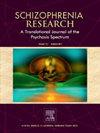Divergent changes in complement pathway gene expression in schizophrenia and bipolar disorder: Links to inflammation and neurogenesis in the subependymal zone
IF 3.6
2区 医学
Q1 PSYCHIATRY
引用次数: 0
Abstract
Deficits in neurogenesis markers in the subependymal zone (SEZ) are associated with elevated inflammation in schizophrenia and bipolar disorder. However, the extent to which complement factors are also changed in the SEZ of these major psychiatric disorders and their impact on neurogenesis remains poorly understood. We extracted RNA from the SEZ of 93 brains, including controls (n = 32), schizophrenia (n = 32), and bipolar disorder (n = 29) cases. Quantitative RT-PCR measured 13 complement transcripts encoding initiators, convertases, effectors or inhibitors. Differences in abundance were analysed by diagnosis and inflammatory subgroups (high- or low-inflammation), which were previously defined by SEZ cytokine and inflammation marker expression.
Complement mRNAs C1QA (p = 0.011), C1QB (p < 0.001), C1R (p = 0.027), and Factor B (p = 0.025) were increased in high-inflammation schizophrenia versus low-inflammation controls. Conversely, high-inflammation bipolar cases had decreased C1QC (p = 0.011) and C3 (p = 0.003). Complement mRNAs C1R (SCZ, p = 0.010; BD, p = 0.047), C1S (SCZ, p = 0.026; BD, p = 0.017), and Factor B (BD, p = 0.025) were decreased in low-inflammation schizophrenia and bipolar subgroups versus low-inflammation controls. Complement inhibitors varied by subgroup: Factor H was increased in high-inflammation schizophrenia (p < 0.001), and CD59 in high-inflammation bipolar disorder (p = 0.020). Complement activator and inhibitor mRNAs were positively correlated with quiescent neural stem cell marker GFAPD (q < 0.05) but negatively with immature neuron markers DLX6-AS1 (q < 0.05) and DCX (q < 0.05).
These findings suggest altered complement cascade expression in the SEZ in high- and low-inflammation schizophrenia and bipolar disorder, with opposite directional changes suggesting distinct molecular pathology. Complement activation may promote stem cell quiescence and reduce differentiation or survival of newborn neurons.
精神分裂症和双相情感障碍中补体通路基因表达的不同变化:与室管膜下区炎症和神经发生有关
室管膜下区(SEZ)神经发生标志物的缺陷与精神分裂症和双相情感障碍的炎症升高有关。然而,补体因子在这些主要精神疾病的经济特区的变化程度及其对神经发生的影响仍然知之甚少。我们从93个大脑的SEZ中提取RNA,包括对照组(n = 32)、精神分裂症(n = 32)和双相情感障碍(n = 29)病例。定量RT-PCR检测了13种编码启动物、转化酶、效应物或抑制剂的补体转录物。通过诊断和炎症亚组(高或低炎症)分析丰度差异,这些亚组先前由SEZ细胞因子和炎症标志物表达定义。补体mrna C1QA (p = 0.011), C1QB (p <;0.001)、C1R (p = 0.027)和因子B (p = 0.025)在高炎症性精神分裂症对照组与低炎症性对照组相比增加。相反,高炎症双相患者的C1QC (p = 0.011)和C3 (p = 0.003)降低。补体mrna C1R (SCZ, p = 0.010;BD, p = 0.047), C1S (SCZ, p = 0.026;与低炎症对照组相比,低炎症精神分裂症和双相亚组的BD (p = 0.017)和因子B (BD, p = 0.025)降低。补体抑制剂因亚组而异:高炎症性精神分裂症患者H因子升高(p <;0.001),高炎症双相情感障碍的CD59 (p = 0.020)。补体激活因子和抑制因子mrna与静止神经干细胞标记物GFAPD呈正相关(q <;与未成熟神经元标志物DLX6-AS1呈负相关(q <;0.05)和DCX (q <;0.05)。这些发现表明,在高炎症和低炎症的精神分裂症和双相情感障碍中,SEZ补体级联表达发生了改变,相反的方向变化表明不同的分子病理。补体激活可能促进干细胞静止,减少新生神经元的分化或存活。
本文章由计算机程序翻译,如有差异,请以英文原文为准。
求助全文
约1分钟内获得全文
求助全文
来源期刊

Schizophrenia Research
医学-精神病学
CiteScore
7.50
自引率
8.90%
发文量
429
审稿时长
10.2 weeks
期刊介绍:
As official journal of the Schizophrenia International Research Society (SIRS) Schizophrenia Research is THE journal of choice for international researchers and clinicians to share their work with the global schizophrenia research community. More than 6000 institutes have online or print (or both) access to this journal - the largest specialist journal in the field, with the largest readership!
Schizophrenia Research''s time to first decision is as fast as 6 weeks and its publishing speed is as fast as 4 weeks until online publication (corrected proof/Article in Press) after acceptance and 14 weeks from acceptance until publication in a printed issue.
The journal publishes novel papers that really contribute to understanding the biology and treatment of schizophrenic disorders; Schizophrenia Research brings together biological, clinical and psychological research in order to stimulate the synthesis of findings from all disciplines involved in improving patient outcomes in schizophrenia.
 求助内容:
求助内容: 应助结果提醒方式:
应助结果提醒方式:


